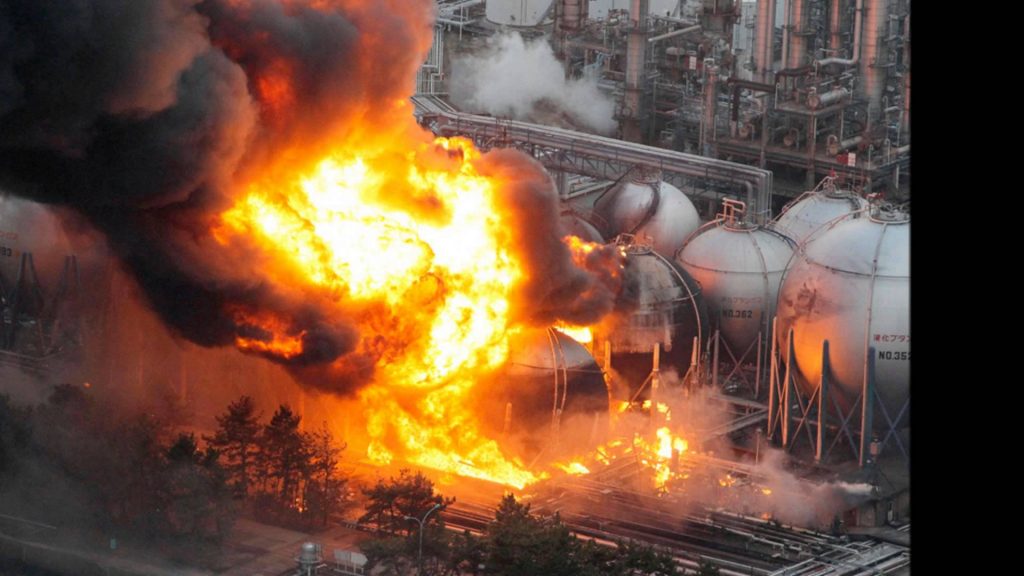Natural disasters are very common but tragic events around the world. From earthquakes to tornadoes, geological disasters can cause increasingly damaging effects, affecting the landscape and those who find themselves there. But when these events are combined with man-made artifacts, the effects might be even greater. An example of this is the Fukushima Disaster in Japan, the worst nuclear disaster since the 1986 Chernobyl incident.1 But the cause of this horrific disaster wasn’t particularly a man-made event. In fact, it all started with a wave.

On March 11, 2011, an earthquake with a magnitude 9.0—the worst to ever hit Japan—hit the country. It was such a powerful catastrophe, that Japan’s main island, Honshu, was permanently moved more than two meters to the east. As the earthquake gained momentum, waves up to 40 meters began crushing the country’s coast. The effects of the earthquake and the waves were too much for the Japanese. More than 20,000 people died or went missing and hundreds of thousands more lost their homes.2 But the worst was yet to come. Fifty minutes after the initial earthquake, a ten-meter high sea wall hit the Fukushima Daiichi (Number One) nuclear power plant. The water flooded the plant’s emergency power generators, knocking vital cooling systems offline, triggering a meltdown of reactor fuel rods. These then leaked deadly radiation into the coastal atmosphere of Japan. With the cooling systems not working, hydrogen gas built up in the reactor buildings, causing several hydrogen explosions in the following days of the earthquake.3

Because of the highly toxic radioactive material that leaked to the surrounding areas of the power plant, the government began to evacuate 80,000 people from a twelve-mile radius. Technicians turned to several things to try to cool the nuclear fuel, like using fresh water, seawater, and injecting nitrogen into the reactor containment buildings to prevent further explosions.4 But despite the efforts to try to help the people of Honshu, the government didn’t tell the people the truth. The official statistics of the event and even the admittance that the meltdown had taken place weren’t disclosed until eighty-eight days later.5
It was estimated that more than 800,000 tons of highly-radioactive material sat near the accident, which was slowly getting into the ground and moving towards the ocean. Although many people were evacuated, there were still many that couldn’t leave. The government installed temporary housing that was intended to house tens of thousands of people after the disaster for twenty-four months. But five years after the disaster, thousands of people were still living where they were surrounded by the radioactive material. Many of those who remained were the elderly and low-income families who had few options to move away.6

Several months after the disaster, people in other parts of Japan began rallying to help these people and bring an end to nuclear power plants in Japan. This pushed forward for the closure of all of the other nuclear plants in Japan for maintenance and inspection.7 These protests also pressured the government to issue a report on the disaster at Fukushima. This report criticized TEPCO (the Tokyo Electric and Power Company) for failing to address concerns about safeguards at the plant. This report also included information about how TEPCO officials had ignored engineers’ concerns that a seawall constructed to protect against major tsunamis as they had seen on March 11 was not sufficient. The report additionally criticized safety regulators for not implementing proper safety measures and for failing to adopt global nuclear safety standards.8 This was really important for the Japanese because TEPCO had always emphasized that the nuclear generators were “fail-safe,” that the facility was completely earthquake resistant and that the reactors would be able to withstand a major tremor.9
Five years after the disaster in Japan, several policies were changed to address the rising concerns of the Japanese population regarding nuclear power plants. The major decision of this kind was the decision to phase-out nuclear power plants during the 2030s as part of Innovative Strategy for Energy and the Environment adopted by the cabinet of the Democratic Party of Japan (DPJ).10 TEPCO is still facing criticism regarding the amount of nuclear material that was leaked into the environment and it is estimated that cleanup operations could take up to forty years.11
- Will Ripley, Junko Ogura, and James Griffiths, “Fukushima: Five Years after Japan’s Worst Nuclear Disaster,” CNN, March 11, 2016, sec. World. ↵
- Encyclopedia Britannica, 2018, s.v. “Fukushima Accident.” ↵
- New World Encyclopedia, 2017, s.v. “Fukushima nuclear disaster.” ↵
- New World Encyclopedia, 2017, s.v. “Fukushima nuclear disaster.” ↵
- Will Ripley, Junko Ogura, and James Griffiths, “Fukushima: Five Years after Japan’s Worst Nuclear Disaster,” CNN, March 11, 2016, sec. World. ↵
- Will Ripley, Junko Ogura, and James Griffiths, “Fukushima: Five Years after Japan’s Worst Nuclear Disaster,” CNN, March 11, 2016, sec. World. ↵
- New World Encyclopedia, 2017, s.v. “Fukushima nuclear disaster,” ↵
- Encyclopedia Britannica, 2018, s.v. “Fukushima Accident.” ↵
- Akira Nakamura and Masao Kikuchi. “What We Know, and What We Have Not Yet Learned: Triple Disasters and the Fukushima Nuclear Fiasco in Japan,” Public Administration Review 71, no. 6 (2011): 894. ↵
- Rie Watanabe, “After the Fukushima Disaster: Japan’s Nuclear Policy Change from 2011 to 2012,” Review Of Policy Research 33, no. 6 (2016): 623. ↵
- Alexis Dudden, “The Ongoing Disaster,” The Journal of Asian Studies 71, no. 2 (2012): 349. ↵




111 comments
Santos Mencio
The story of the Fukushima is a decade old at this point but it’s still fresh in my mind. As someone who advocates for the widespread adoption of nuclear energy it’s a story I’m intimately familiar with and it still saddens me to this day. This article does a wonderful job elaborating on the tragedy that befell the people the Japanese government has forsaken. Hopefully things will get better for them and we can remember the lessons learned from Fukushima going forward.
Kimberly Parker
Natural disasters are one of the few things that nothing can be done to stop them. I have lived in various parts of the world, but I have never had the experience of actually being a part of a natural disaster. But reading about the aftermath of them is just heartbreaking, and reading this article about the Fukushima Disaster honestly crushed my heart. Learning that more than 20,000 people died or went missing and hundreds of thousands more lost their homes and that that wasn’t even the worst of it, is just something that breaks me because there isn’t anything that we can do to prevent this from happening because it isn’t a man-made event. It happens naturally
Amanda Quiroz
When you really think about it, you know that you can’t do much to prevent a natural disaster so I feel like you can’t call it a man-made event regardless of whether or not it hit the power plant. The government was trying to help but I do believe that they could have at least informed the people of the truth.
Mia Correa
Hearing about natural disasters is so surreal for me because I have lived in San Antonio, Texas all of my life; therefore, I rarely experience natural disasters. I did not know about The Fukushima Disaster until I read this article. It breaks my heart reading about how many people were affected by the Fukushima Disaster and knowing that the workers had raised awareness about their concerns that a seawall would not be sufficient yet the government did nothing- it saddens me even more. Governments all over the world NEED to listen to their citizens and do what they can to help in any way possible.
Saira Locke
Japan is horrible for not informing their people of the hazardous nuclear air that they were living in. They should’ve the safety of their people first. I agree that tsunami walls will not be a practical solution because tsunamis are incredibly strong and will eventually knock the wall down causing more debris and destruction. It is crazy. To me that this extremely strong earthquake killed so many people and was also capable of moving Japan more than 2 meters to the East.
Rahni Hingoranee
I think this article is interesting because as Americans we tend to focus solely on the natural disasters that happen within our country or even so far as our continent, barely. It is unfortunate to hear about the devastation that was created as a result of this. The fact that it is partially man-made and had such fatal effects is a huge concern. Nuclear energy is not something to be taken lightly.
Stephanie Cerda
I remember watching a documentary about this a while back. I have also looked into the discussions about who should take responsibility for this, even though it wasn’t exactly man made, there’s still some regulations that maybe could have helped, at least thats what some discussions points are about. I think the aftermath has been terrible, and the evidence of how people are still affected by this disaster is obvious. It makes you think about what damages nuclear energy can case, apart from the obvious ones we speak about. It’s not safe and it leads to the question, why are we not looking into better alternatives?
Paul Garza
I faintly remember hearing about this back in 2011. It’s pretty sad that the government was failing its people by keeping the truth from them and enabling the Tokyo Electric and Power company. I can imagine the frustration of the people and their fear, these rich companies ignored the safety of innocent people and the health of our oceans just to make money. I applaud the people of Japan for making the government bring change.
Steven Clinton
Great article! The Fukashima disaster was a catastrophe that reveal the true dangers of nuclear plants. Natural disasters often take place out of nowhere and really nothing can be done to stop them. But the Nuclear fallout after the event could of been avoided had the government listen to the concerns of the plant engineers. The Nuclear fallout plague Japan for decades after. The Fukashima disaster remains a lesson to all those will nuclear plants: plan for the unexpected.
Sierra Salas
Reading this article was disturbing due to the fact that TEPCO not only ignored the concerns these engineers had about the insufficient seawall that was created, but also because they gave information stating that the nuclear generators were safe and could withstand an earthquake. Giving out false information about the safety of the Japanese and their environment is horrible. Although the article was sad and upsetting to read, it is important because it can educate the public about the dangers of nuclear plants.